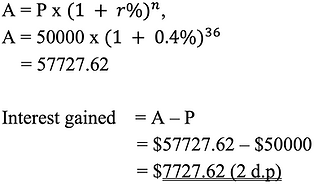Percentages
Simple Interest vs Compound Interest
This is one of the topics in Percentages that most students find very difficult to understand.
Let P = Principal (money deposited in the bank)
I = interest gained
A = amount of money deposited in the bank + total interest gained
n = the number of periods
r% = interest rate per period

Example 1:
John invests $400 at a rate of 5% per year simple interest.
Find the amount John has after 3 years.
Since this is simple interest, we know the interest gained each year is the same.
Interest per year = P x r% = $400 x 5% = $20
Total interest for 3 years = $20 x 3 = $60
Therefore, the amount after 3 years = P + I = $400 + $60 = $460
The difference between simple interest and compound interest is the way the interest accumulates. Simple interest accumulates only on the principal balance, the interest earned is not reinvested. This means the amount of interest gained each year is the same. Compound interest increases to both the principal balance and the accumulated interest.
Example 2:
June invests $200 at a rate of 4% per year compound interest.
Calculate the amount June has after 5 years.
P = 200, r% = 4%, n = 5

Example 3:
Sam decides to deposit $50000 in a bank for 3 years at an interest rate of 4.8% p.a. ( per year).
How much interest will he gain if the interest is compounded monthly?
P = $50000, n = 3 years, r% = 4.8% per year,
Since the interest is compounded monthly, we have to find the interest rate per month,
which is = 4.8% / 12 = 0.4%
n = the number of periods or the number of times the bank calculates the interest during the period
Each year has 12 months
In 3 years = 3 x 12 = 36 months = 36 times
therefore n = 12 x 3 = 36

In the IGCSE Exam, Percentage questions always come with harder topics like Logarithm or Mensuration. If you make sure you learn them well and know how to apply them correctly, you should be able to get a full score for the question.